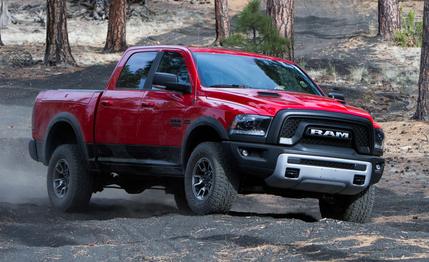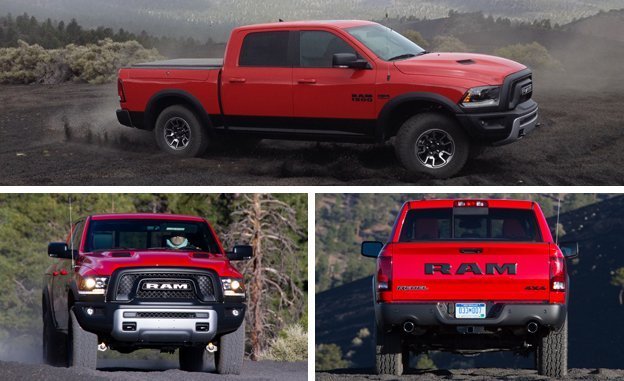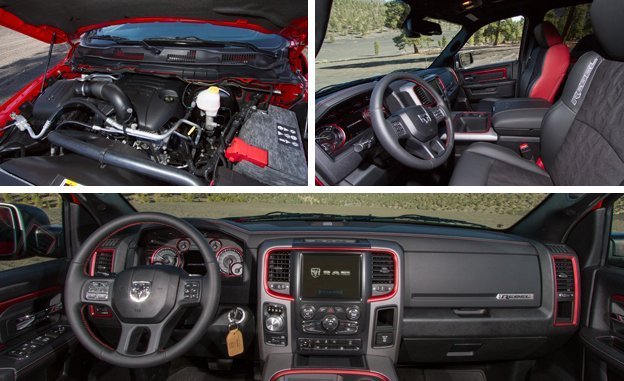
 First Drive Review
First Drive Review
The Ram Rebel 1500 is not the brand’s response to the Ford F-150 Raptor. Nor is it a competitor for the scandalously lifted, mega-tired, hard-core rigs that can be caught prowling sand dunes or posing on the SEMA show floor. No, despite its defiant name, the Rebel is a wholly cooperative vehicle. Essentially a Ram 1500 outfitted with off-road duds, the Rebel packs the same towing and cargo-hauling capabilities and comfortable cabin as a regular 1500, but it offers from the factory the kinds of upgrades that a buyer with an itch for casual off-roading might piece together from the aftermarket.
Before we get into the mechanical upgrades, let’s address the exterior. As we noted when the Rebel debuted at the 2015 Detroit auto show, the large grille—which has neither a bit of chrome nor even a hint of a crosshair—is a pretty big departure. Instead, brand identity is handled by the massive “RAM” lettering on the blacked-out grille and on the tailgate. It certainly won’t appeal to wallflowers, but then the name “Rebel” should have tipped you off from the get-go, right? Below the grille is a powder-coated steel brush guard/skid plate (additional skid plates protect the oil pan and the transfer case); above it is a twin-snorkel aluminum hood. Wheel-well flares borrowed from the Power Wagon frame unique 17-inch aluminum rims shod with 33-inch-tall 285/70 Toyo Open Country A/T tires.
To back up the ornamental bravado, Ram gave the Rebel some real hardware, too, fitting specially tuned Bilstein dampers, a slower steering ratio, and a softer rear anti-roll bar. What’s more, the Rebel’s air suspension provides for an additional inch of maximum lift (the Rebel’s standard ride height also is one-inch higher than a non-Rebel’s; thus, with the air suspension at full stroke, the Rebel, in the immortal words of Spinal Tap’s Nigel Tufnel, goes one more). Suspension fully extended, the Rebel has an approach angle of 25.3 degrees, easily beating the 17.9-degree number of the 2015 Chevrolet Silverado 4x4 but falling a cactus needle shy of the 2015 Ford F-150 4x4’s 25.5 degrees. Still, the Rebel is no rock climber, despite its graphics.
The Rebel goes on sale in July and comes only as a Crew Cab with the five-foot seven-inch bed. The base price will be approximately $45,000. The quartet of Rebels available during our excursion were all equipped with the 5.7-liter Hemi V-8, eight-speed automatic transmission, on-demand four-wheel drive, and a 3.92:1 axle ratio. The 3.6-liter Pentastar V-6 also will be available in combination with the eight-speed auto and part-time 4WD; the Rebel is the only way to get the 3.92 rear axle with the six-cylinder. Those interested in the Rebel-lious look alone can get a two-wheel-drive version, which comes paired only with the 5.7-liter V-8. A 3.21:1 rear axle is available for any V-8 models, but we wouldn’t bother with it.


Capability is unaffected by the off-road makeover, with the 5.7-liter 4x4 Rebel sporting the same 1530-pound payload as the standard 1500 and a 10,130-pound tow rating, a scant 20 pounds less than a comparable non-Rebel. Likewise, EPA fuel-economy estimates are unchanged at 15 mpg city and 21 highway (22 mpg highway with rear-wheel drive).
To see just how well the spate of Rebel-specific tweaks performs in the wild, we headed to the mountainous region of northern Arizona, at times climbing to more than 8500 feet above sea level while traversing the San Francisco Volcanic Field. Last active sometime between 1040 and 1100 AD, the volcano fields lay adjacent to the Kaibab and Coconino national forests, giving us a variety of terrain over which to abuse the Rebel—all in the name of journalism, of course. To ensure we brought the four pre-production units back alive, a pair of hard-core, winch-equipped Ram 2500 Power Wagons led the way.
Traveling on the paved roads leading out of Flagstaff, the Rebel felt decidedly Ram 1500–like. Despite the slower steering and tread-tastic Toyo tires, this Rebel displayed the same docile road manners and consistent braking behavior as its more reserved siblings. If it weren’t for the bright-red anodized vent rings and steering-wheel stitching, plus the “Rebel” logo on the glove box, you’d have no reason to think you were in anything but a Ram 1500. Well, there were also the black-and-red seats, which, in addition to being all-day comfortable and supportive, feature a shadow print of the tires’ aggressive tread pattern. Black-and-red floor mats with channels deep enough to capture all the mountain mud we could track into the cabin are a welcome touch.
Driving on pavement, we became a bit concerned—the tires seemed far too quiet to be worth a darn off the road. Concerns regarding traction were abated, however, as we entered Cinder Hills OHV Area, the tires sinking into the deep, gravel-like ash that coats sections of the area’s 13,000-plus acres. Our trucks were equipped with the “anti-spin” rear axle. Although not a true locker, it did a good job of ensuring that the V-8’s 395 horsepower and 410 lb-ft of torque—the same ratings as in the standard 1500—were fed to both rear wheels as they churned through the seemingly limitless supply of volcanic ash. (Fun fact: NASA used sections of the area to simulate, in 1:1 scale, the moon’s surface to prepare and test equipment for the first lunar landing.) When it came time to climb, we shifted into four-wheel drive via the dash-mounted button and proceeded to ascend tight, twisty, not-quite two-tracks with aplomb, kickbacks and driveline binding either nonexistent or masterfully concealed by the power steering. A gravel plateau about halfway up one of the steepest climbs proved to be an excellent playground for whipping up a cloud of “space dust” by spinning wider and wider circles into the ash. Despite our best efforts, the winches on the Power Wagons remained unused.


The preferred technique for descending consisted of leaving the transfer case in low range and selecting a gear—generally first or second—via the wheel-mounted gear-selector buttons and idling downward using engine braking. Traction control is disabled in low range, so on descents like this, with Wile E. Coyote cartoon–style cliffs bordering the trail, it’s better to keep it slow and steady rather than mucking up things with excessive pedal inputs.
After a short jaunt on paved roads, we hit the kind of terrain owners are likely to encounter most frequently: muddy two-tracks. Again the Rebel persevered, slipping and sliding across the muck, but never out of control. When it began to snow, the fun factor increased exponentially. This is when we were nearly rear-ended by an overzealous driver in one of the Power Wagons. Thankfully, he chose the ditch over the large “RAM” target affixed to our tailgate. Now, we did see a Nissan Sentra artfully plying the same paths, but it’s likely the driver was a local, or maybe just huffing bath salts.
Later, we managed to ditch our official and gracious group leader and found some beautiful trails that branched veinlike from the main arteries, and which guided us higher and higher through stands of ponderosa pines. Steep and rock-strewn, it was here the Rebel felt most at home. Competent enough to traverse the toughest terrain that 90 percent of owners will ever likely encounter, the Rebel doesn’t have to be a baby monster truck. Whether the fact that it tries to look like one is a good or bad thing, we’ll leave it to you to decide.